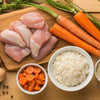Understanding When Can I Feed My Puppy Hard Dog Food: A Comprehensive Guide
- Houndsy
Table of Contents
- Introduction
- Understanding Puppy Nutrition
- The Weaning Process
- When to Feed Hard Dog Food
- Choosing the Right Hard Dog Food
- Tips for a Smooth Transition
- Conclusion
- FAQ
Introduction
New puppy owners often find themselves in a whirlwind of emotions and responsibilities—joy, excitement, and plenty of questions, especially about feeding. For instance, many of us often wonder, when can I feed my puppy hard dog food? This transition is essential for our growing pups, as the right nutrition lays the foundation for a happy, healthy dog. Shifting from a diet of puppy milk to solid food not only influences their temperament, energy levels, and oral health but also supports their proper growth and development.
As we embark on this journey together, we will explore the precise timing and methods for introducing hard dog food to your puppy's diet. We'll also discuss how weaning works, the nutritional needs of growing pups, and what makes a quality puppy food. By the end of this article, you'll have a clear understanding of how to make this important transition smoothly and successfully, setting your furry friend up for a lifetime of health and happiness.
Understanding Puppy Nutrition
The Basics of Puppy Development
Puppies, like human babies, grow and change rapidly in the first few months of life. Their nutritional needs are different from those of adult dogs, reflecting their unique growth requirements. Puppies rely on their mother’s milk until they are around 4 weeks old, at which point the weaning process begins, marking a significant shift in their diet.
During this stage, nutritional support is crucial. Puppies require food that is specifically formulated for them, rich in calories, protein, and essential vitamins and minerals. This ensures adequate energy for play and growth, supporting their emerging personalities and overall well-being.
Key Nutrients for Growth
To understand when we can confidently introduce hard dog food, we need to grasp what puppies need nutritionally:
- High-quality Protein: Essential for muscle development and overall growth.
- Calcium and Phosphorus: Vital for developing strong bones and teeth.
- Omega Fatty Acids: Promote healthy brain development and a shiny coat.
- Vitamins and Minerals: Supports immune health and bodily functions.
As we consider these needs, it's clear that transitioning too early or too late can have a significant impact on your puppy’s health.
The Weaning Process
What is Weaning?
Weaning is the gradual transition from a diet of milk to solid food. This crucial stage typically begins around the ages of 3 to 4 weeks and extends until 6 to 8 weeks, depending on the puppy's development. It’s essential that we manage this process carefully to ensure our little ones adjust well.
Steps to Introduce Solid Food
-
Start with Soft Food: At about 4 weeks, begin introducing a soft, moist diet, which can be made from wet puppy food combined with a little water or puppy milk replacer. The consistency should be akin to oatmeal.
-
Gradual Transition: As your puppy becomes accustomed to eating soft food, you can start to introduce transitional textures. By about 6 weeks, we can reduce the amount of moisture, advancing towards a thicker consistency.
-
Introducing Kibble: By 8 weeks of age, most puppies are ready to try dry kibble. However, to ease their transition from soft to hard, we can moisten kibble with warm water to soften it.
Signs Your Puppy is Ready for Hard Food
- Teeth Development: By 6 to 8 weeks, your puppy will start to have baby teeth, signaling their readiness for solid food.
- Curiosity About Food: If your puppy shows interest in your food or attempts to nibble at the food of other pets, it may indicate they are ready for a shift.
- Weight Gain: A steadily increasing weight is a sign of healthy growth, bolstering the idea of introducing harder food.
At Houndsy, we emphasize the importance of tailored nutrition for our pets. Our Houndsy Kibble Dispenser makes it easy to ensure your puppy receives measured servings of high-quality kibble, without the mess.
When to Feed Hard Dog Food
Typical Timeline
- 4 Weeks: Start with soft, moistened food.
- 5 to 6 Weeks: Gradually include more solid soft food.
- 6 to 8 Weeks: Introduce hard food while still offering some moisture.
This timeline can vary based on your puppy's breed and individual development, so it is paramount to monitor their reactions and consult your veterinarian when you're unsure.
Feeding Schedule
You should feed your puppy several smaller meals throughout the day. For instance:
- Up to 4 Months Old: 4 meals per day.
- 4 to 6 Months: Transition to 3 meals daily.
- 6 Months and Older: Move to 2 meals per day.
This routine aligns with their nutritional needs, ensuring they receive consistent energy and nutrients.
Choosing the Right Hard Dog Food
What to Look For
When selecting a hard dog food, focus on quality ingredients and proper formulations. Here are some guidelines:
- Look for Puppy-Specific Formulas: These are tailored to provide the nutrition that young dogs need.
- Quality Ingredients: Choose foods featuring high-quality proteins, whole grains, and real vegetables—avoid fillers and artificial additives.
- Appropriate Size Kibble: Ensure the kibble size is manageable for your puppy’s size and dental development.
At Houndsy, we want to simplify your feeding experience. Our Houndsy Kibble Dispenser is perfect for distributing high-quality kibble designed for puppies, maintaining enjoyable meal times and minimizing mess.
Brands to Consider
Though there are numerous brands available, it's vital to choose a food that fits your puppy's specific needs. Look for products like:
- Royal Canin Puppy Food: Exceptional formulations tailored for specific breeds.
- Wellness Core Puppy Formula: Combines a high-protein diet with nutrient-rich ingredients.
- Purina Pro Plan Puppy Food: Provides a variety of successful formulas, including both dry and wet options.
Always consult your veterinarian for recommendations tailored to your puppy’s specific dietary requirements.
Tips for a Smooth Transition
Gradual Introduction
To ease your puppy into a diet of hard dog food, we can take a gradual approach:
- Mix Kibble with Soft Food: Start by mixing a small amount of dry food with their usual moistened food.
- Gradually Increase Dry Food Proportion: Slowly increase the kibble ratio over several days or weeks, depending on how well your puppy adjusts.
- Monitor Their Reaction: Keep an eye on potential digestive issues or hesitance in eating and adjust accordingly.
Feeding Routine
Establish a regular feeding schedule in a comfortable, distraction-free environment. This consistency helps reinforce a positive nutritional experience for your pup.
Fresh Water Access
Don’t forget to provide constant access to fresh water, especially as you transition away from softer foods that contain higher moisture content.
Conclusion
Transitioning your puppy to hard dog food is a crucial element of their early developmental journey. We, at Houndsy, emphasize that this process should be gradual, carefully observing our puppies’ readiness at each stage. By providing appropriate nutrition, we set them up for a healthy future filled with vigor and vitality.
Want to enhance your puppy's feeding experience even further? Check out our Houndsy Kibble Dispenser, designed to simplify meal times and ensure your growing pup gets the nutrition they deserve.
Do you have more questions about your puppy's nutrition or feeding habits? Be sure to check out our FAQ section below to find answers to all your puppy feeding inquiries.
FAQ
What age can puppies start eating solid food?
Puppies can begin to eat very soft solid food around 4 weeks of age, transitioning fully to dry food by the time they are 8 weeks old.
How do I know if my puppy is ready for hard food?
Look for signs such as the development of baby teeth, curiosity about your food, steady weight gain, and showing interest in solid food after observing their mother.
Is dry food better for puppies?
Dry food is beneficial because it encourages chewing, which promotes healthy teeth and jaws. It also offers a convenient way to manage portion sizes using our Houndsy Kibble Dispenser for hassle-free feeding.
How much hard dog food should I feed my puppy?
The amount varies depending on breed size and age. Consult the feeding guidelines on the food packaging and speak with your vet for personalized recommendations.
Can I mix wet and dry food?
Yes, many pet parents find that combining wet and dry food can make nutrition more appealing for their puppies, aiding in transition and variety.
By keeping these guidelines in mind, we can make feeding our beloved pups a joyous experience, maximizing their health and happiness for years to come. Continue to explore more feeding tips and insights as your puppy grows alongside you!












